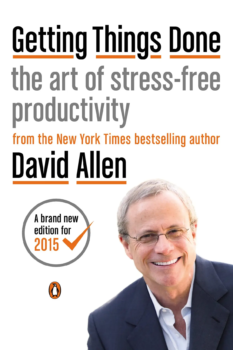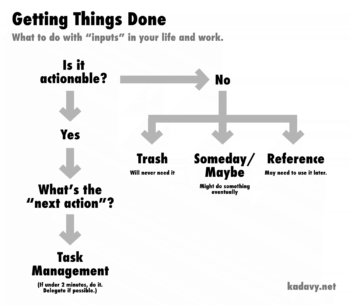Subscribe to blog updates via email »
Getting Things Done Summary – Love Your Work, Episode 242
 When I first heard of Getting Things Done, I was skeptical. How could it possibly live up to the fanaticism of its cult following? But once I saw the power of the “next action,” of “someday/maybes,” and of organizing tasks by “context,” I knew there was a good reason for the hype: “GTD” works.
When I first heard of Getting Things Done, I was skeptical. How could it possibly live up to the fanaticism of its cult following? But once I saw the power of the “next action,” of “someday/maybes,” and of organizing tasks by “context,” I knew there was a good reason for the hype: “GTD” works.
More than fifteen years later, GTD still helps me stay productive and in control of all of the things going on in life and work. GTD has helped me write three books, build a business, and move to South America. I regularly re-read it, and I always find new ways to apply its principles and techniques.

WANT TO WRITE A BOOK?
Download your FREE copy of How to Write a Book »
(for a limited time)
Here’s my Getting Things Done summary – in my own words – after many years of practice and two podcast interviews with author David Allen.
Listen to this Getting Things Done summary
- Listen in iTunes >>
- Download as an MP3 by right-clicking here and choosing “save as.”
- RSS feed for Love Your Work
The principles that make GTD work
These are not “principles” as expressed in the Getting Things Done book, but this is my summary of its most important ideas.
1. Trusted System: GTD is your “trusted system”
The most important idea behind GTD is to get everything out of your head and into a “trusted system.”
What is a trusted system? A “trusted” system is a system in which you can “trust” that you will engage appropriately with everything in the system.
2. Appropriate Engagement: Your trusted system helps you “engage appropriately”
GTD handles a wider breadth of things than your typical to-do list/calendar combination. Because GTD helps you “engage appropriately” with everything.
What does it mean to “engage appropriately?” That means you’re doing no more and no less than is necessary to achieve your goal.
You can trust your system will remind you to buy cat food only when you’re physically capable of buying cat food, and before you run out of cat food.
You can also trust your system to hold ideas that you may or may not act upon. If you daydream about moving abroad, you can trust your system to hold that idea and remind you periodically, so you won’t forget to do whatever you do or don’t want to do about it.
So GTD handles everything from important tasks that must get done to fleeting thoughts that you merely might want to do something about.
3. Close Open Loops: GTD keeps your mind free of “open loops”
Build a trusted system that helps you engage appropriately with everything, and your mental energy will be free to handle whatever is going on in the moment.
This is because your trusted system keeps your mind free of open loops. If you can’t trust that you’ll buy cat food before you run out, you’ll be thinking about it. If you can’t trust that you’ll revisit that idea about moving abroad, you’ll be thinking about it. You’ll have open loops in your mind.
These open loops use mental energy that you could use on other things.
These open loops also make you feel like a victim of the things you have to do. It’s demoralizing to keep reminding yourself something needs to get done because you’re also reminding yourself that you haven’t followed through. If you trust it will get done, you don’t have to remind yourself.
As David Allen says, ”Your mind is for having ideas, not for holding them.”
4. Bottom-Up: GTD is a “bottom-up” approach to personal organization
By getting control of the ground-level things in your life, you have more energy to think about the higher-level things. By trusting that you’ll buy cat food, you have more energy to think about how your idea to move abroad fits into your long-term goals and your life purpose.
One quick exercise to get a taste of GTD
One quick way to get a taste of GTD: Write down every single thing that’s on your mind that either needs to get done, or that may need to get done. Don’t worry about doing those things, just get them out of your head.
You may feel a little overwhelmed from writing all of those things down, but you probably also feel a lot lighter. You’ve just done the first of the five key steps to mastering GTD.
The five-step process of GTD
- Capture: Capture everything. Anything you need to act on or might need to act on needs to be captured. Get it out of your head and into the system.
- Clarify: With each thing, you’re asking yourself Is this actionable? If it’s not actionable, what should you do with it? If it is actionable, what’s the “next action” (more on this soon).
- Organize: Put the thing in the right place. If it’s actionable, it’s in your task management system. If you don’t need it, it goes in the trash. If you might need it, you store it for reference.
- Reflect: Review and think about the things in your system, regularly. How often? Often enough to keep them out of your mind, which helps you trust your “trusted system.”
- Engage: Do what you intended to do with the things. That might be taking action, that might be not taking action.
Whatever action you do take, that’s the “next action.”

Identify the “next action”
If you take away only one idea from this Getting Things Done summary, it should be the “next action.” The “next action” is what it sounds like: What is the next thing you can do about this thing you’re thinking about?
I used to write vague items on my to-do list: I’d write “Mom,” to remind me Mom’s birthday was coming up, and that I needed to buy her a gift.
Look at how many steps removed “Mom” was from the next action!
You might think the next action was to buy Mom a gift, but it wasn’t. Instead, the next action was “brainstorm gift ideas for Mom.” That’s easier to act upon than just “Mom.”
You might not think it makes a difference. But – like closing open loops – identifying the next action saves mental energy. When you look at your to-do list you don’t have to wonder what action to take.
And sometimes you don’t need to take action at all.
Keep a “someday/maybes” list
If you take away only two ideas from this Getting Things Done summary, it should be the “next action,” and the “someday/maybes” list.
Why? Because these are the two ideas that free up the most energy. The next action makes it easier to act. Your someday/maybe list makes it easier to not act.
Before I knew about someday/maybe, I’d make one of two mistakes: I’d either write something down on my to-do list, not realizing I didn’t really intend to do it, or I’d recognize that I didn’t really intend to do it, and so not write it down, and thus keep thinking about it.
Both of these were the wrong way.
Your someday/maybes list lets you capture things you would like to do, only it’s not the right time or you’re not yet sure you want to do them.
Because the things you someday or maybe want to do are in your “trusted system” you close the loops, and you stop thinking about them.
But for your someday/maybe list to work, you have to review it regularly.
Do a “weekly review”
If you take only three ideas from this Getting Things Done summary, it should be the “next action,” the “someday/maybes” list, and the “weekly review.”
Because the weekly review is what puts the “trusted” in “trusted system.” Remember the five-step process behind GTD: Capture, Clarify, Organize, Reflect, and Engage.
Capturing, Clarifying, and Organizing help you identify what to do and be sure you’ll do it. Reflecting – which you do in your weekly review – helps you feel confident nothing is falling through the cracks.
Find a time once a week where you consistently have the time and energy to Reflect on your life and work. Make sure you’ve Captured, Clarified, and Organized everything.
I do my weekly review on Sunday afternoons. Some people like Fridays. It is really a game-changing habit.
There’s your Getting Things Done summary! (some final ideas)
Those are the most important ideas behind GTD from my fifteen years of using it. There is of course a whole book’s worth of ideas behind the system. I highly recommend you pick up the book. Honorable mention includes:
- Contexts: Assign a “context” to your tasks, such as “@home” or “@office.” Some to-do items, you can only do in certain places.
- Projects: If you think it’s a task, it’s often a “project.” (If it takes more than one task to achieve your desired outcome).
- Two-Minute Rule: If you’re Clarifying, and you come across a next action that will take two minutes or less, do it right away.
Download your free “GTD toolkit”
I’ve been using GTD for more than fifteen years. It’s helped me write three books, build a business, and travel the world.
Want to know which tools I count on to get things done? I’ll instantly send you the tools I count on most if you sign up to my newsletter here.
Mind Management, Not Time Management available for pre-order!
After nearly a decade of work, Mind Management, Not Time Management debuts October 27th! This book will show you how to manage your mental energy to be productive when creativity matters. Pre-order it today!
My Weekly Newsletter: Love Mondays
Start off each week with a dose of inspiration to help you make it as a creative. Sign up at: kadavy.net/mondays
Join the Patreon for (new) bonus content!
I've been adding lots of new content to Patreon. Join the Patreon »
Subscribe to Love Your Work
Listen to the Podcast
- Listen in iTunes >>
- Download as an MP3 by right-clicking here and choosing “save as.”
- RSS feed for Love Your Work
Theme music: Dorena “At Sea”, from the album About Everything And More. By Arrangement with Deep Elm Records. Listen on Spotify »


